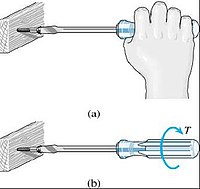
Photo from wikipedia
Introduction Effective teamwork is critical for the delivery of safe, quality care of the surgical patient. Current surgical team members, however, often foster professional tribalism1 and a silo mentality2, impeding… Click to show full abstract
Introduction Effective teamwork is critical for the delivery of safe, quality care of the surgical patient. Current surgical team members, however, often foster professional tribalism1 and a silo mentality2, impeding team interaction. Although several educational strategies, such as simulation-based training (SBT), can help improve surgical team function, their effectiveness requires a means to measure the team performance accurately, efficiently, and quickly, especially in the busy clinical environment. In order to enhance ease-of-use, we revised the Teamwork Assessment Scale (TAS), an 11-item instrument used to evaluate individual- and team-based performance containing three subscales: team-based behaviors (TBB, five items), shared mental model (SMM, three items), and adaptive communication and response (ACR, three items).3 Methods Refinement of the TAS occurred in three phases: 1) factor analysis of its three subscales using data from prior SBT sessions of inter-professional students; 2) a comprehensive literature review of recently published surgical team assessment tools; and 3) qualitative analysis of focus group interviews of practicing surgical team members. Revision and consolidation of the TAS using data from all three phases of analysis then occurred to improve ease-of-use without loss of scope. Results Upon completion of all three phases of analysis, the revision of the 11-item TAS resulted in the creation of a 5-item instrument, known as the Quick TAS (QTAS). The TBB subscale decreased from six to two items; the SMM decreased from three items to one item, and the ACR decreased from three to two items. This consolidation improved efficiency of completing the instrument. Conclusions We successfully consolidated the 11-item TAS into a 5-item QTAS that, due to its decreased number of items, will enhance its ease-of-use, especially in a busy clinical environment. Next steps include piloting its use in SBT in order to demonstrate its validity and reliability for targeted populations. This work was supported through a Southern Group on Educational Affairs (SGEA) Medical Education Scholarship, Research and Evaluation (MESRE) Grant. References Gillespie BM, Chaboyer W, Wallis M, Fenwick C. Why isn’t ‘time out’ being implemented? An exploratory study. Qual Saf Health Care 2010;19:103–106. Bleakley A. You are who I say you are: the rhetorical construction of identity in the operating theatre. J Workplace Learning 2006;18(7–8):414–425. Paige JT, Garbee DD, Kozmenko V, Yu Q, Kozmenko L, Yang T, Bonanno L, Swartz W. Getting a head start: high fidelity, simulation-based operating room team training of inter-professional students. J Am Coll Surg. 2014 18(1):140–9.
Journal Title: BMJ Simulation and Technology Enhanced Learning
Year Published: 2019
Link to full text (if available)
Share on Social Media: Sign Up to like & get
recommendations!